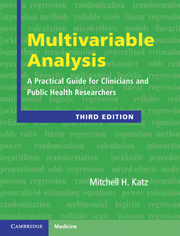Book contents
- Frontmatter
- Contents
- Preface
- 1 Introduction
- 2 Common uses of multivariable models
- 3 Outcome variables in multivariable analysis
- 4 Independent variables in multivariable analysis
- 5 Relationship of independent variables to one another
- 6 Setting up a multivariable analysis
- 7 Performing the analysis
- 8 Interpreting the results
- 9 Delving deeper: Checking the underlying assumptions of the analysis
- 10 Propensity scores
- 11 Correlated observations
- 12 Validation of models
- 13 Special topics
- 14 Publishing your study
- 15 Summary: Steps for constructing a multivariable model
- Index
15 - Summary: Steps for constructing a multivariable model
Published online by Cambridge University Press: 01 April 2011
- Frontmatter
- Contents
- Preface
- 1 Introduction
- 2 Common uses of multivariable models
- 3 Outcome variables in multivariable analysis
- 4 Independent variables in multivariable analysis
- 5 Relationship of independent variables to one another
- 6 Setting up a multivariable analysis
- 7 Performing the analysis
- 8 Interpreting the results
- 9 Delving deeper: Checking the underlying assumptions of the analysis
- 10 Propensity scores
- 11 Correlated observations
- 12 Validation of models
- 13 Special topics
- 14 Publishing your study
- 15 Summary: Steps for constructing a multivariable model
- Index
Summary
Step 1. Based on the type of outcome variable you have, use Table 3.1 to determine the type of multivariable model to perform (if you have repeated observations of your outcome see Table 11.2).
Step 2. Perform univariate statistics to understand the distribution of your independent and outcome variables. Assess for implausible values, significant departures from normal distribution of interval variables, gaps in values, and outliers (Section 3.2C).
Step 3. Perform bivariate analysis of your independent variables against your outcome variable.
Step 4. If you have any nominal independent variables transform them into multiple dichotomous (“dummied”) variables (Section 4.2).
Step 5. Assess whether interval-independent variables have a linear relationship with the outcome (Section 4.3). If not, transform the variable, use splines, or create multiple dichotomous variables.
Step 6. Run a correlation matrix. If any pair of independent variables are correlated at > 0.90 (multicollinearity), decide which one to keep and which one to exclude. If any pair of variables are correlated at 0.80 to 0.90 consider dropping one (Chapter 5).
Step 7. Assess how much missing data you will have in your multivariable analysis. Choose a strategy for dealing with missing cases from Table 6.4.
Step 8. Perform the analysis (Chapter 7).
Step 9. Assess how well your model fits the data. (e.g., F test, likelihood ratio test, adjusted R2, Hosmer–Lemeshow test, c index) (Section 8.2).
Step 10. Assess the strength of your individual covariates in estimating outcome (Section 8.3).
Information
- Type
- Chapter
- Information
- Multivariable AnalysisA Practical Guide for Clinicians and Public Health Researchers, pp. 227 - 228Publisher: Cambridge University PressPrint publication year: 2011
